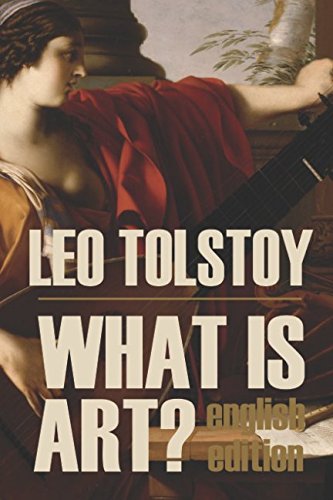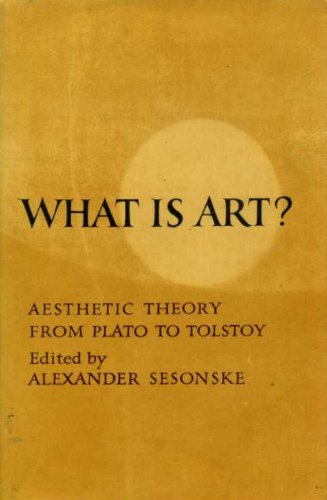All Formats & Editions

What Is Art?
During his decades of world fame as a novelist, Tolstoy also wrote prolifically in a series of essays and polemics on issues of morality, social justice and religion. These works culminated in What is Art?, published in 1898. Impassioned and iconoclastic, this powerfully influential...

What is Art?
While Tolstoy may be best remembered as the talented Russian author of such monumentally great works as "War and Peace" and "Anna Karenina", he also wrote prolifically in essay format on various subjects. In this volume Tolstoy turns his attention to the study of aesthetics...

What Is Art?
![¿Que es el Arte? [Spanish] 1540469883 Book Cover](https://i.thriftbooks.com/api/imagehandler/l/8F7275248B6E6708DD47C41ADE7E9422180B7101.jpeg)
¿Que es el Arte? [Spanish]
" Qu es el arte?", es un texto en donde Tolstoi despliega todo su armamento literario, po tico, espiritual, para definir lo que, a su parecer, es el arte. Un texto extenso, de hecho, para ser le do en la pantalla del monitor. Es dif cil hallarlo editado, al menos aqu en Argentina,...

What is Art? (English Version, Abridged)
Leo Tolstoy's fascinating classic treatise on art is as relevant today as it was over one hundred years ago. Highly-readable, often witty, anyone with an interest in the nature of art and its connection to what it is to be human will find this book a treat.Be sure to LOOK INSIDE...

What Is Art?
During his decades of world fame as a novelist, Tolstoy also wrote prolifically in a series of essays and polemics on issues of morality, social justice and religion. These works culminated in What is Art?, published in 1898. Impassioned and iconoclastic, this powerfully influential...

Tolstoy: What Is Art?
Both critics and admirers of Tolstoy's great novel were shocked by the savage iconoclasm of his What is Art? when it appeared in 1898. How was it that this great artist could condemn the works of Shakespeare, Raphael, Beethoven and even his own Anna Karenina as 'false art'? Today's...

What is Art
This work has been selected by scholars as being culturally important, and is part of the knowledge base of civilization as we know it. This work was reproduced from the original artifact, and remains as true to the original work as possible. Therefore, you will see the original...

What is Art?
2014 paperback edition of Leo Tolstoy's controversial indictment of ?sthetic theory. Tolstoy contends that much of European art since the Renaissance is not "true" art but "counterfeit" art, marked by being mannered, imitative, sensationalist, and overly intellectual. Few of...
![¿Que es el arte? [Spanish] 8492491299 Book Cover](https://m.media-amazon.com/images/I/417W9DkGwWL._SL500_.jpg)
¿Que es el arte? [Spanish]

What is Art?
The climax of a number of articles and polemics on morality, social justice, and religion is this sophisticated investigation of the essence of art. Tolstoy considers and rejects the notion that beauty may unveil and reinvent, seeing the question of the nature of art as a...

What Is Art?
This work has been selected by scholars as being culturally important and is part of the knowledge base of civilization as we know it. This work is in the public domain in the United States of America, and possibly other nations. Within the United States, you may freely...

What Is Art and Essays on Art

What is art?: And essays on art (The World's cl...

What is Art?
The climax of a number of articles and polemics on morality, social justice, and religion is this sophisticated investigation of the essence of art. Tolstoy considers and rejects the notion that beauty may unveil and reinvent, seeing the question of the nature of art as a...

What Is Art

What Is Art

What Is Art?

What Is Art?

What Is Art?
This work has been selected by scholars as being culturally important, and is part of the knowledge base of civilization as we know it. This work is in the "public domain in the United States of America, and possibly other nations. Within the United States, you may freely...

What Is Art?
This work has been selected by scholars as being culturally important and is part of the knowledge base of civilization as we know it. This work is in the public domain in the United States of America, and possibly other nations. Within the United States, you may freely...

What Is Art and Essays on Art

What Is Art?
Leo Tolstoy is one of the most celebrated novelists of all time. As well as writing literary classics such as Anna Karenina and War and Peace he was also the author of some hugely influential critical and philosophical works. First published in 1898 his book...

What Is Art?
What Is Art? is the result of fifteen years' reflection on the nature and purpose of art. Tolstoy claims that all good art is related to the authentic life of the broader community and that the aesthetic value of a work of art is not independent of its moral content...




